weight NISSAN NV200 2020 Owners Manual
[x] Cancel search | Manufacturer: NISSAN, Model Year: 2020, Model line: NV200, Model: NISSAN NV200 2020Pages: 300, PDF Size: 3.26 MB
Page 43 of 300
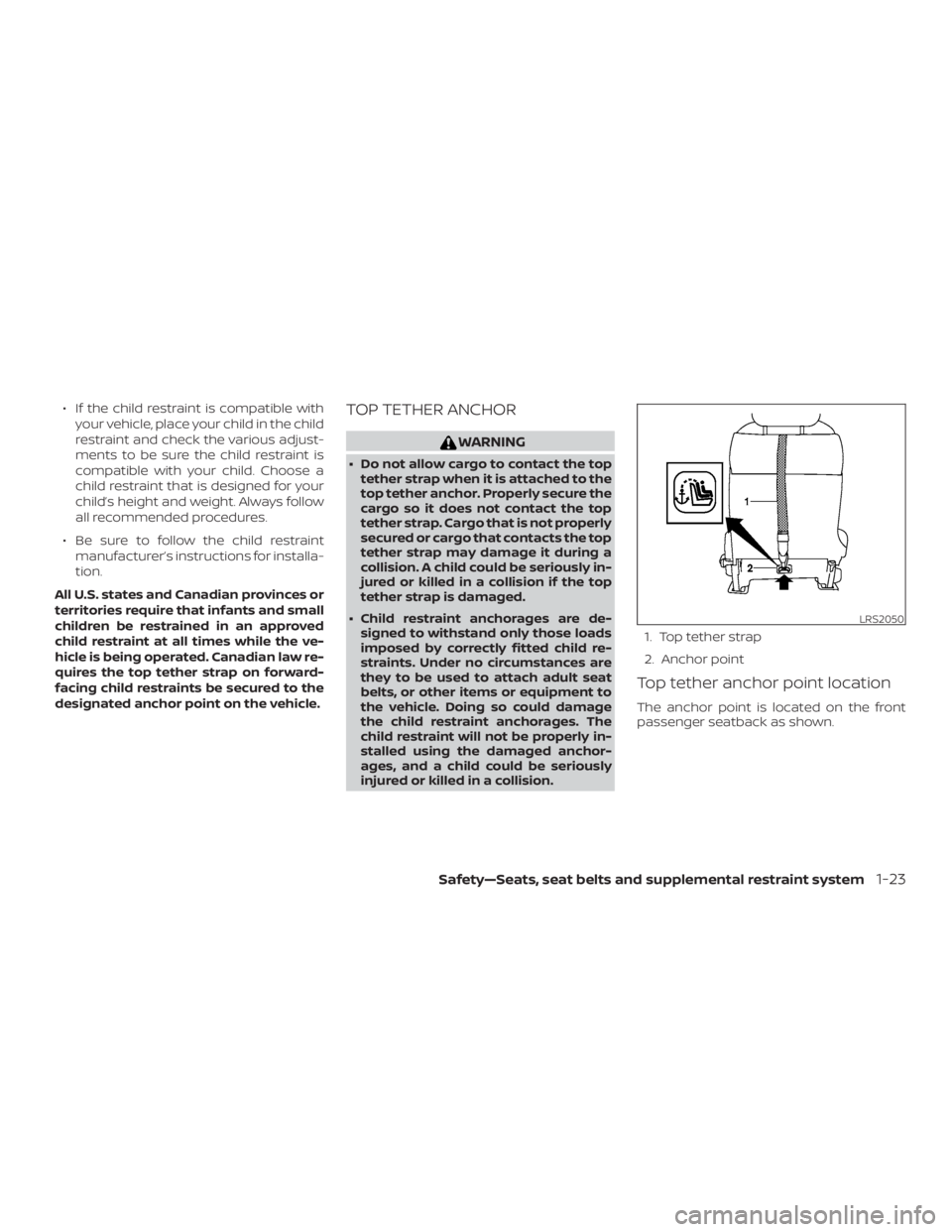
∙ If the child restraint is compatible withyour vehicle, place your child in the child
restraint and check the various adjust-
ments to be sure the child restraint is
compatible with your child. Choose a
child restraint that is designed for your
child’s height and weight. Always follow
all recommended procedures.
∙ Be sure to follow the child restraint manufacturer’s instructions for installa-
tion.
All U.S. states and Canadian provinces or
territories require that infants and small
children be restrained in an approved
child restraint at all times while the ve-
hicle is being operated. Canadian law re-
quires the top tether strap on forward-
facing child restraints be secured to the
designated anchor point on the vehicle.TOP TETHER ANCHOR
Page 53 of 300
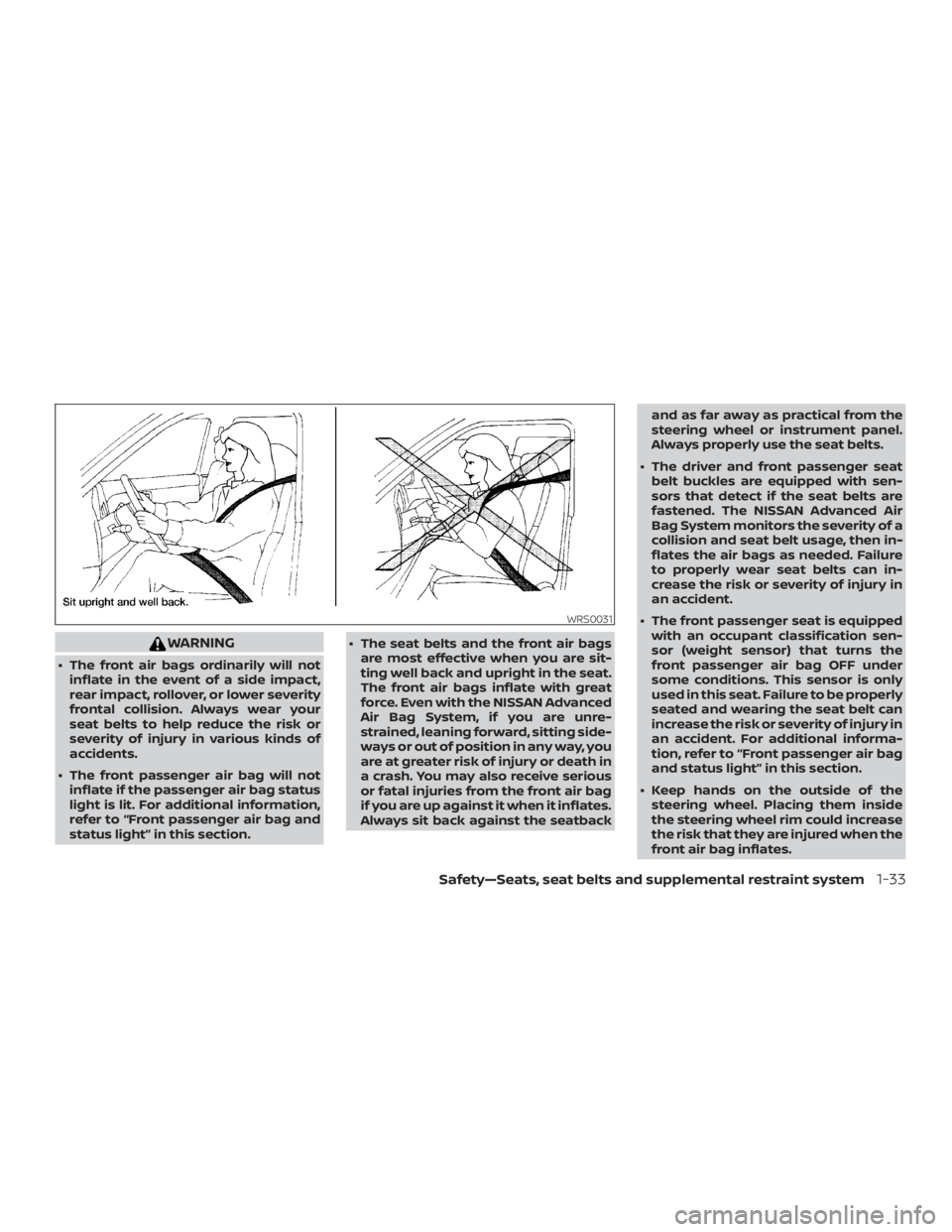
WARNING
∙ The front air bags ordinarily will notinflate in the event of a side impact,
rear impact, rollover, or lower severity
frontal collision. Always wear your
seat belts to help reduce the risk or
severity of injury in various kinds of
accidents.
∙ The front passenger air bag will not inflate if the passenger air bag status
light is lit. For additional information,
refer to “Front passenger air bag and
status light” in this section. ∙ The seat belts and the front air bags
are most effective when you are sit-
ting well back and upright in the seat.
The front air bags inflate with great
force. Even with the NISSAN Advanced
Air Bag System, if you are unre-
strained, leaning forward, sitting side-
ways or out of position in any way, you
are at greater risk of injury or death in
a crash. You may also receive serious
or fatal injuries from the front air bag
if you are up against it when it inflates.
Always sit back against the seatback and as far away as practical from the
steering wheel or instrument panel.
Always properly use the seat belts.
∙ The driver and front passenger seat belt buckles are equipped with sen-
sors that detect if the seat belts are
fastened. The NISSAN Advanced Air
Bag System monitors the severity of a
collision and seat belt usage, then in-
flates the air bags as needed. Failure
to properly wear seat belts can in-
crease the risk or severity of injury in
an accident.
∙ The front passenger seat is equipped with an occupant classification sen-
sor (weight sensor) that turns the
front passenger air bag OFF under
some conditions. This sensor is only
used in this seat. Failure to be properly
seated and wearing the seat belt can
increase the risk or severity of injury in
an accident. For additional informa-
tion, refer to “Front passenger air bag
and status light” in this section.
∙ Keep hands on the outside of the steering wheel. Placing them inside
the steering wheel rim could increase
the risk that they are injured when the
front air bag inflates.
Page 59 of 300
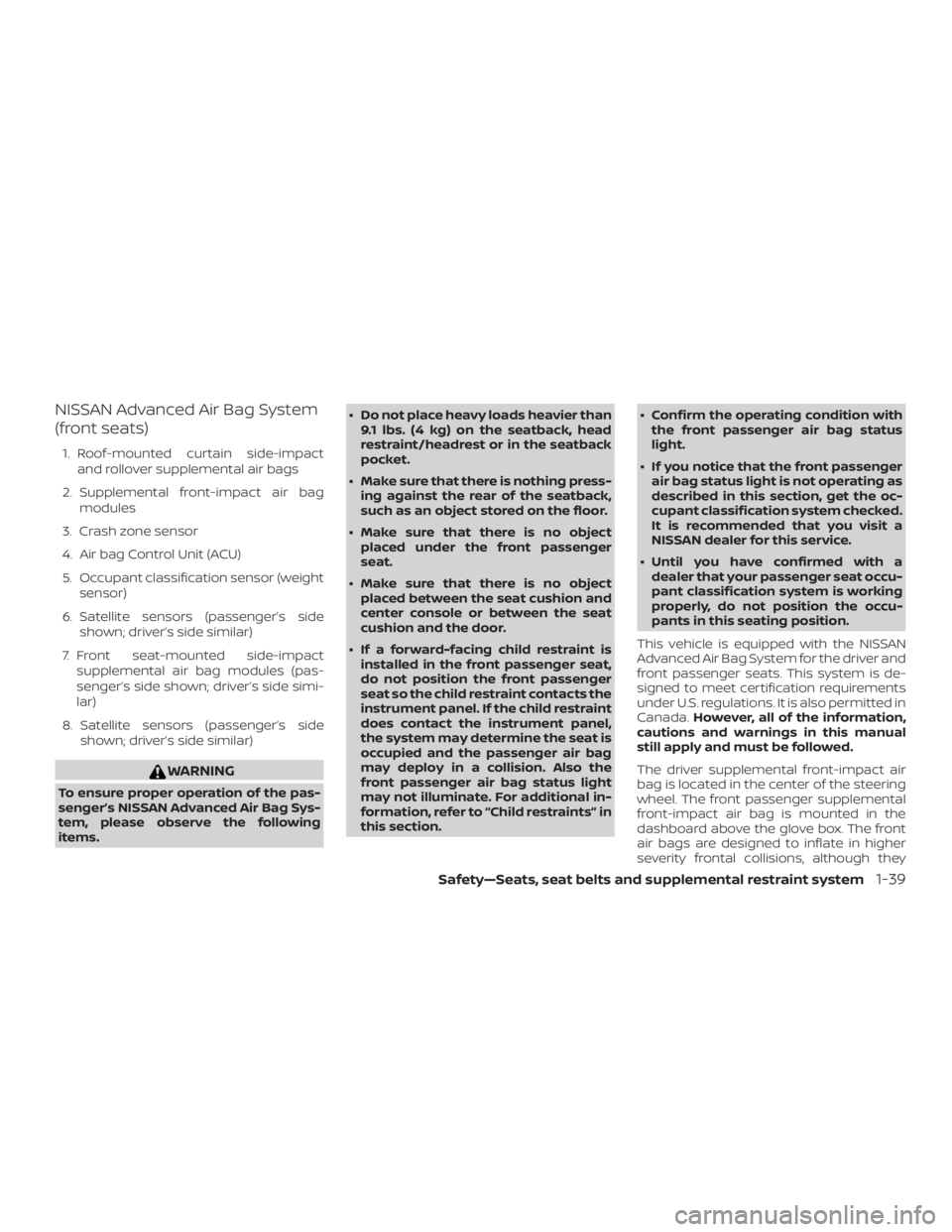
NISSAN Advanced Air Bag System
(front seats)
1. Roof-mounted curtain side-impactand rollover supplemental air bags
2. Supplemental front-impact air bag modules
3. Crash zone sensor
4. Air bag Control Unit (ACU)
5. Occupant classification sensor (weight sensor)
6. Satellite sensors (passenger’s side shown; driver’s side similar)
7. Front seat-mounted side-impact supplemental air bag modules (pas-
senger’s side shown; driver’s side simi-
lar)
8. Satellite sensors (passenger’s side shown; driver’s side similar)
Page 282 of 300
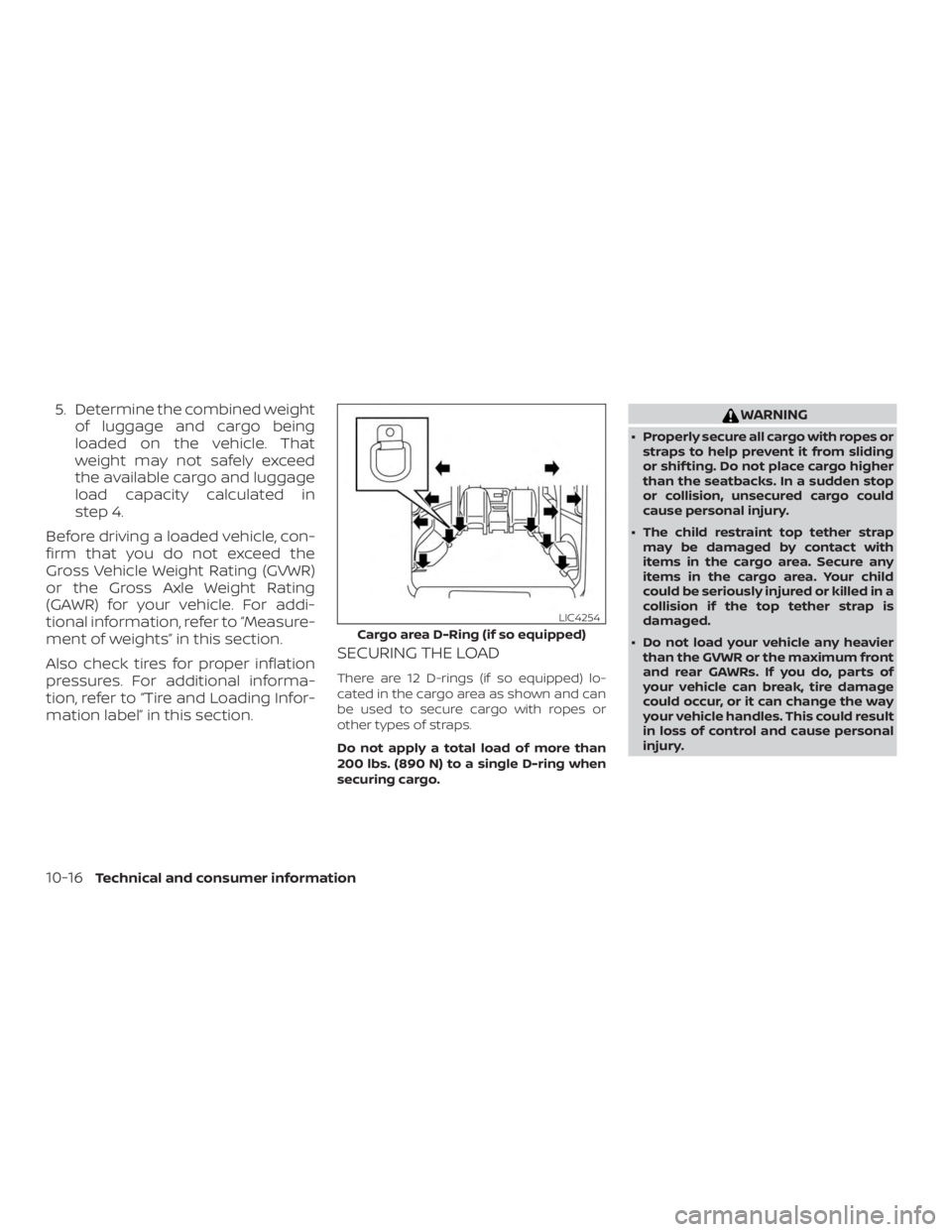
5. Determine the combined weightof luggage and cargo being
loaded on the vehicle. That
weight may not safely exceed
the available cargo and luggage
load capacity calculated in
step 4.
Before driving a loaded vehicle, con-
firm that you do not exceed the
Gross Vehicle Weight Rating (GVWR)
or the Gross Axle Weight Rating
(GAWR) for your vehicle. For addi-
tional information, refer to “Measure-
ment of weights” in this section.
Also check tires for proper inflation
pressures. For additional informa-
tion, refer to “Tire and Loading Infor-
mation label” in this section.
SECURING THE LOAD
There are 12 D-rings (if so equipped) lo-
cated in the cargo area as shown and can
be used to secure cargo with ropes or
other types of straps.
Do not apply a total load of more than
200 lbs. (890 N) to a single D-ring when
securing cargo.
Page 290 of 300
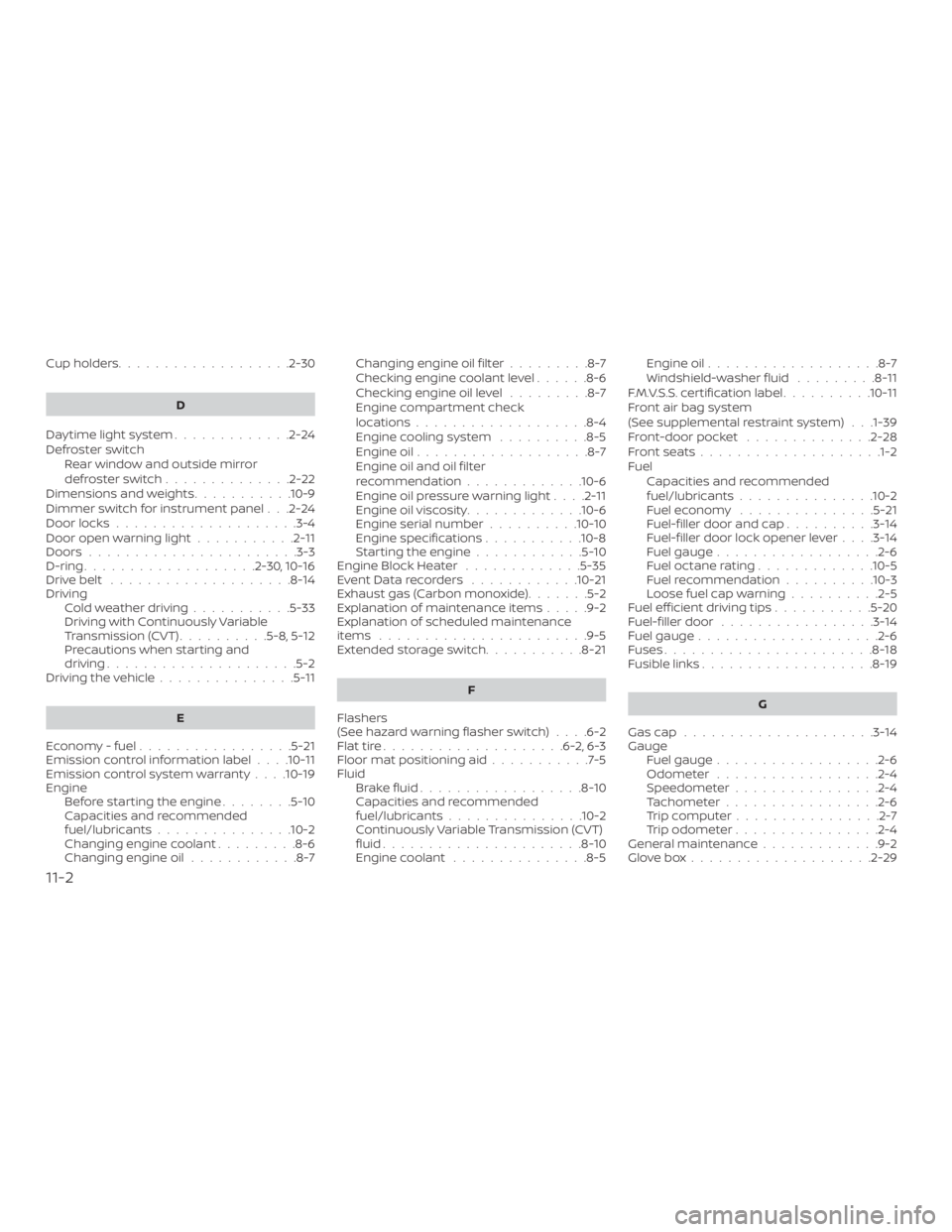
Cupholders...................2-30D
Daytime light system .............2-24
Defroster switch Rear window and outside mirror
defrosterswitch..............2-22
Dimensions and weights ...........10-9
Dimmer switch for instrument panel . . .2-24
Door locks ....................3-4
Door open warning light ...........2-11
Doors .......................3-3
D-ring ...................2-30,10-16
Drivebelt ....................8-14
Driving Coldweatherdriving...........5-33
Driving with Continuously Variable
Transmission (CVT) ..........5-8,5-12
Precautions when starting and
driving .....................5-2
Drivingthevehicle...............5-11
E
Economy - fuel .................5-21
Emission control information label . . . .10-11
Emission control system warranty . . . .10-19
Engine Before starting the engine ........5-10
Capacities and recommended
fuel/lubricants...............10-2
Changing engine coolant .........8-6
Changing engine oil ............8-7 Changing engine oil filter
.........8-7
Checking engine coolant level ......8-6
Checking engine oil level .........8-7
Engine compartment check
locations...................8-4
Engine cooling system ..........8-5
Engine oil ...................8-7
Engine oil and oil filter
recommendation .............10-6
Engine oil pressure warning light ....2-11
Engine oil viscosity .............10-6
Engine serial number ..........10-10
Engine specifications ...........10-8
Starting the engine ............5-10
Engine Block Heater .............5-35
EventDatarecorders ............10-21
Exhaust gas (Carbon monoxide) .......5-2
Explanation of maintenance items .....9-2
Explanation of scheduled maintenance
items .......................9-5
Extended storage switch ...........8-21
F
Flashers
(See hazard warning flasher switch) ....6-2
Flattire....................6-2,6-3
Floormatpositioningaid...........7-5
Fluid Brakefluid..................8-10
Capacities and recommended
fuel/lubricants...............10-2
Continuously Variable Transmission (CVT)
fluid......................8-10
Engine coolant ...............8-5 Engine oil
...................8-7
Windshield-washer fluid .........8-11
F.M.V.S.S. certification label ..........10-11
Front air bag system
(See supplemental restraint system) . . .1-39
Front-door pocket ..............2-28
Frontseats....................1-2
Fuel Capacities and recommended
fuel/lubricants...............10-2
Fuel economy ...............5-21
Fuel-filler door and cap ..........3-14
Fuel-filler door lock opener lever . . . .3-14
Fuel gauge ..................2-6
Fueloctanerating.............10-5
Fuel recommendation ..........10-3
Loosefuelcapwarning..........2-5
Fuel efficient driving tips ...........5-20
Fuel-filler door .................3-14
F
uel gauge ....................2-6
Fuses .......................8-18
Fusiblelinks...................8-19
G
Gascap .....................3-14
Gauge Fuel gauge ..................2-6
Odometer ..................2-4
Speedometer ................2-4
Tachometer .................2-6
Trip computer ................2-7
Trip odometer ................2-4
General maintenance .............9-2
Glovebox....................2-29
11-2
Page 294 of 300
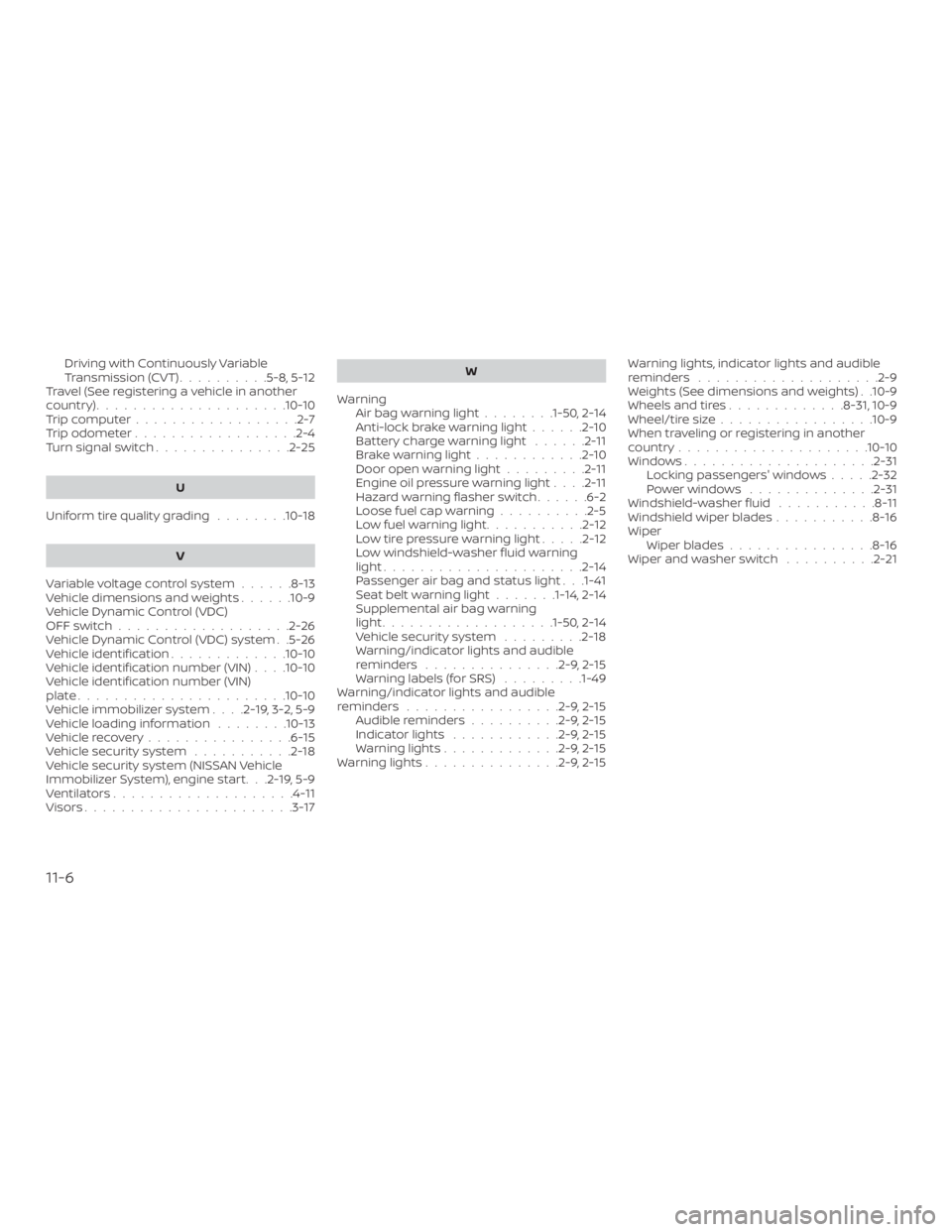
Driving with Continuously Variable
Transmission (CVT)..........5-8,5-12
Travel (See registering a vehicle in another
country) .....................10-10
Trip computer ..................2-7
Trip odometer ..................2-4
Turn signal switch ...............2-25
U
Uniform tire quality grading ........10-18
V
Variable voltage control system ......8-13
Vehicle dimensions and weights ......10-9
Vehicle Dynamic Control (VDC)
OFFswitch...................2-26
Vehicle Dynamic Control (VDC) system . .5-26
Vehicle identification .............10-10
Vehicle identification number (VIN) . . . .10-10
Vehicle identification number (VIN)
plate.......................10-10
Vehicle immobilizer system ....2-19,3-2,5-9
Vehicle loading information ........10-13
Vehiclerecovery................6-15
Vehicle security system ...........2-18
Vehicle security system (NISSAN Vehicle
Immobilizer System), engine start. . .2-19, 5-9
Ventilators ....................4-11
Visors.......................3-17 W
Warning Airbagwarninglight........1-50, 2-14
Anti-lock brake warning light ......2-10
Battery charge warning light ......2-11
Brakewarninglight............2-10
Door open warning light .........2-11
Engine oil pressure warning light ....2-11
Hazard warning flasher switch ......6-2
Loose fuel cap warning ..........2-5
Lowfuelwarninglight...........2-12
Low tire pressure warning light .....2-12
Low windshield-washer fluid warning
light......................2-14
Passenger air bag and status light . . .1-41
Seatbeltwarninglight.......1-14, 2-14
Supplemental air bag warning
light.................. .1-50, 2-14
Vehicle security system .........2-18
Warning/indicator lights and audible
reminders ...............2-9,2-15
Warning labels (for SRS) .........1-49
Warning/indicator lights and audible
reminders .................2-9,2-15
Audible reminders ..........2-9,2-15
Indicatorlights ............2-9,2-15
Warninglights.............2-9,2-15
Warninglights...............2-9,2-15 Warning lights, indicator lights and audible
reminders
....................2-9
Weights (See dimensions and weights) . .10-9
Wheels and tires .............8-31,10-9
Wheel/tire size .................10-9
When traveling or registering in another
country .....................10-10
Windows.....................2-31 Locking passengers' windows .....2-32
Powerwindows ..............2-31
Windshield-washer fluid ...........8-11
Windshield wiper blades ...........8-16
Wiper Wiper blades ................8-16
Wiper and washer switch ..........2-21
11-6